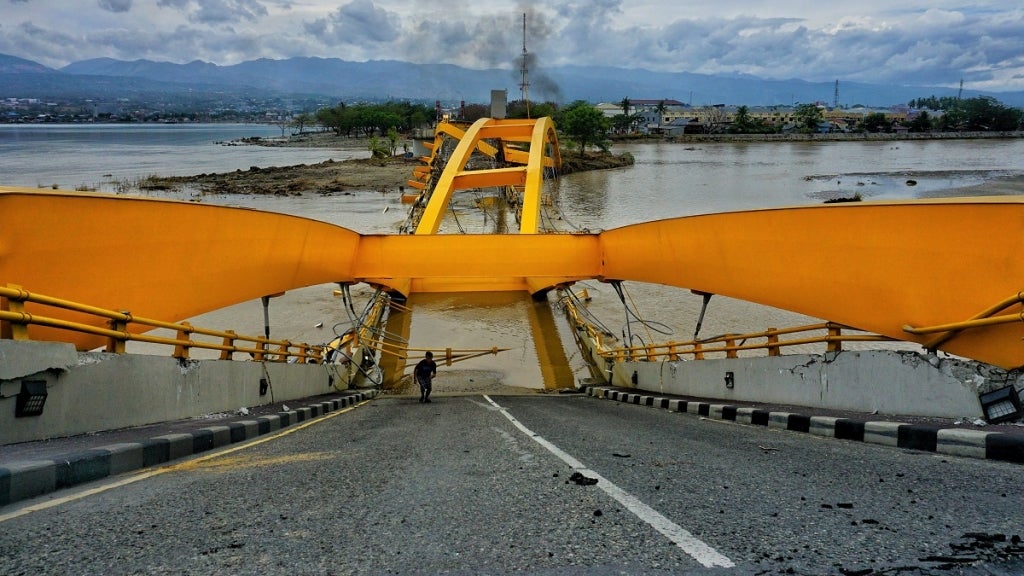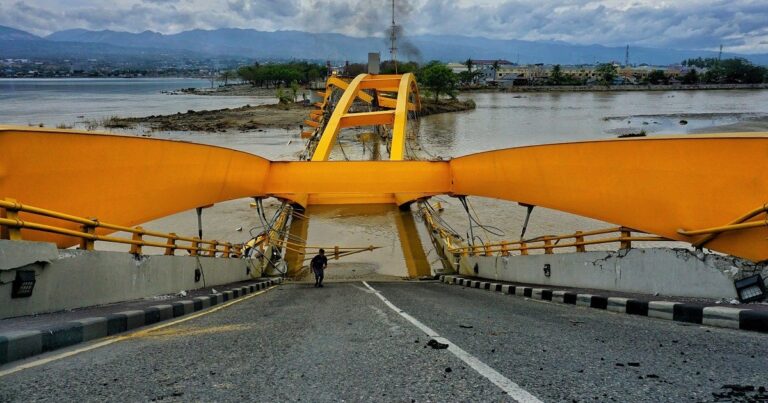
The Palu IV Bridge, commonly known as the Yellow Ponulele Bridge, was the first steel arch bridge in Indonesia and connected East and West Palu, presenting spectacular views of the blue sea with the Sulawesi mountains in the background. It had become a symbol of cohesion for the city and a place for tourists and locals to gather and socialize while enjoying the views and taking photographs. The bridge was an icon for the city of Palu. A sort of Golden Gate Bridge or Brooklyn Bridge for Palu’s population and visitors, who lost their favorite sunset spot unexpectedly when the Yellow Bridge collapsed in 2018 during the tragic earthquake and tsunami that forcefully hit Central Sulawesi. Unfortunately, many other bridges and roads suffered the same fate.
Every year, natural disasters result in substantial loss of life around the world, as well as great tangible and intangible damage that affects 218 million people on average and causes over USD300 billion in overall losses. These events destroy public infrastructure and disrupt services. Indonesia is disproportionately affected, spending an estimated USD300-500 million annually on disaster recovery. Road and bridge infrastructure is harshly affected, with damages to hundreds of kilometers across the country in the last 20 years, of which close to 65% were caused by flooding, followed by the combination of earthquakes and tsunamis, causing over 30% of the damage.
The magnitude 7.5 earthquake and tsunami that struck Central Sulawesi in September of 2018 was particularly tragic, resulting in 4,402 deaths, approximately 170,000 displaced people, and USD1.3 billion in economic losses. Roads and bridges were severely damaged, leaving the population without access to critical services, and complicating emergency management and immediate relief activities. The World Bank has been supporting the Government of Indonesia in the recovery of the region through the reconstruction of assets, technical assistance and capacity building, among other activities. In this context, the Contingency for Disaster Risk Response Component of an ongoing USD250 million loan road project was triggered to support the rehabilitation and reconstruction of roads and bridges. In addition, the Ministry of Public Works and Housing and the World Bank partnered on a technical assistance program, with the support of the Global Facility for Disaster Reduction and Recovery, to promote the systematic inclusion of disaster and climate resilience principles into all stages of road and bridge projects.
National disaster databases and disaster risk assessment systems were also reviewed. This confirmed the importance of focusing on specific disasters that affect roads and bridges disproportionally in Indonesia and the impacts of which can be mitigated through enhanced guidelines and technical specifications. More specifically, the analysis revealed that four hazard types cause the most significant impacts to the road network: landslides, floods, tsunamis and earthquakes.
The study of Indonesia’s national policies revelated that while most of these are comprehensive and generally adequate for improving the resilience of road and bridge infrastructure, opportunities to strengthen planning, design, operation and maintenance, and rehabilitation/reconstruction practices were identified. In particular, some of the main findings and recommendations suggested are:
- That roadside slope failures often occur because of slope instabilities driven by water action and erosion that is aggravated by the fact that it is not always possible to design cut slopes with ideal characteristics. To deal with those failures, it is recommended that (i) new design methods and rock characteristic parameters are introduced to develop solutions that are better adapted to local conditions; (ii) technical solutions to deal with steep slopes such as soil nailing with slope surface protection of geotextiles, wire meshing or pile walls are adopted, and (iii) effective drainage systems are built and special maintenance and monitoring is conducted for critical sites.
- The importance of increasing the awareness of the usefulness of risk maps and enhanced information systems to identify critical locations along the network to plan preventive resilience improvement interventions and hence reduce damage to infrastructure, as well as post-disaster rehabilitation costs.
- The need for more pre- and post-disaster damage assessments, including conducting more site-specific analyses, such as hydraulic analyses of bridge foundations, and more frequent monitoring of critical cases.
As a country highly prone to natural disasters, Indonesia is committed to addressing comprehensively their impacts on lives and infrastructure. The Government continues working intensively on improving specifications, guidelines and practices to enhance road and bridge resilience to such events, leading to reduced material and immaterial damages and overall costs. The significance of roads and bridges relies heavily on their economic function, connecting otherwise isolated areas to opportunities, but also on their social cohesion function, bringing people closer together. The objective is to avoid that the next earthquake, tsunami or great flood results in such catastrophic social and economic outcomes as the ones in Central Sulawesi in 2018.

